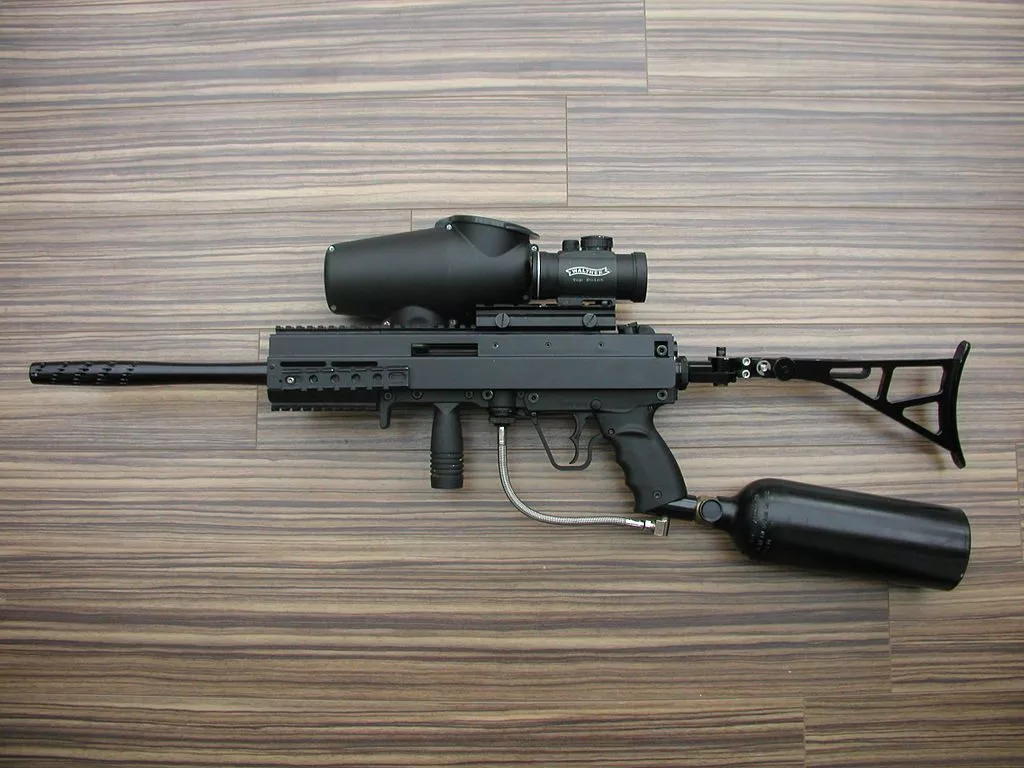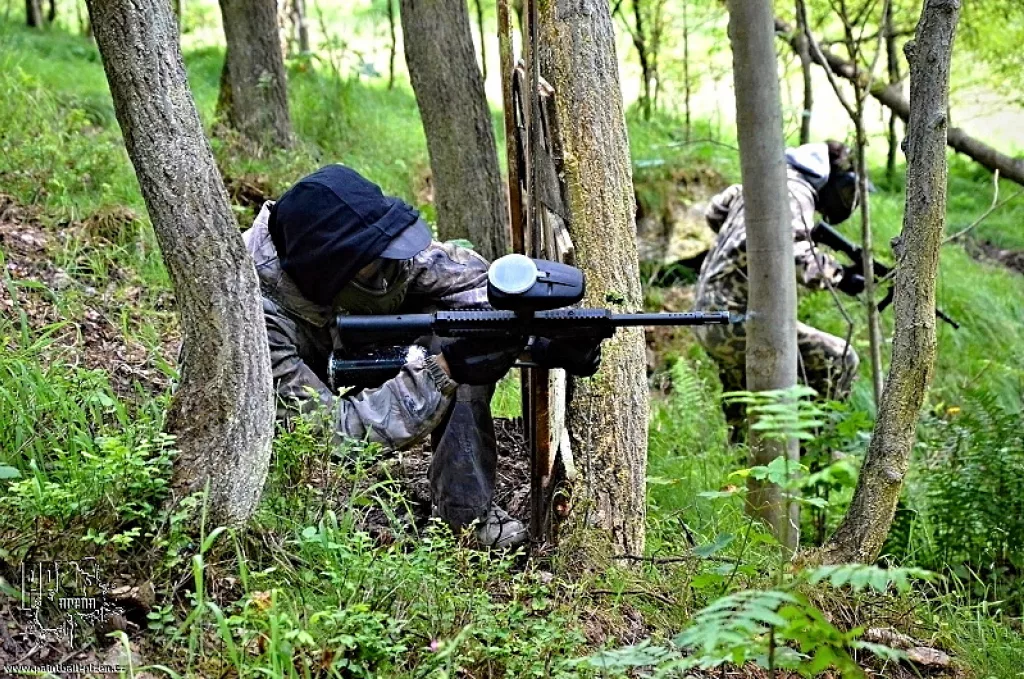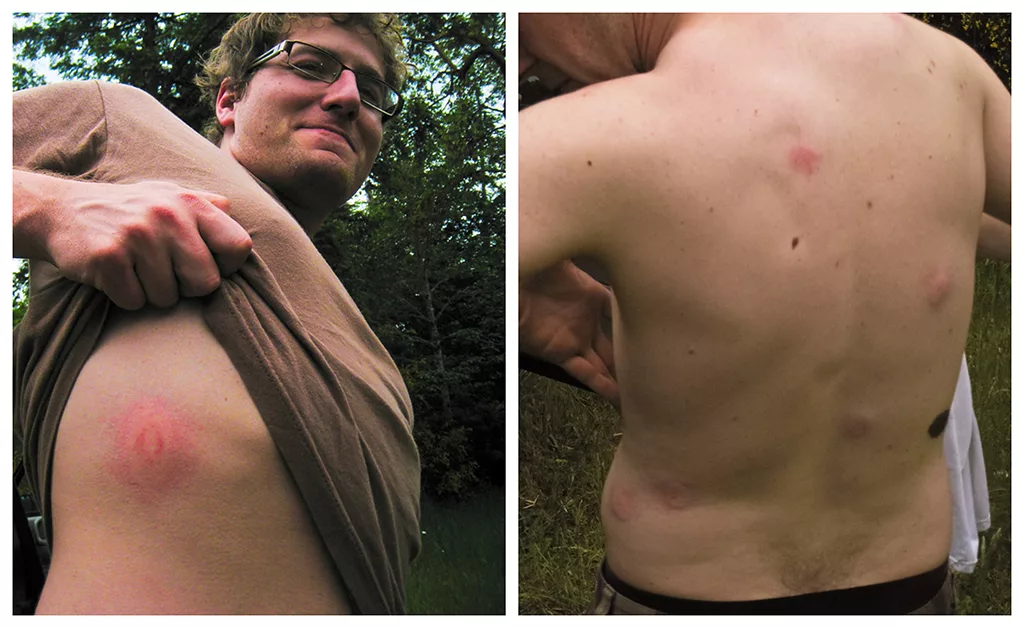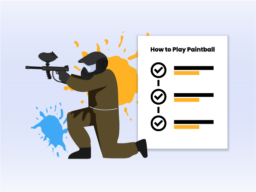If you’ve ever wondered how to play paintball, get ready to bookmark this page.
This guide is your ultimate resource to one of the most fun and exciting ways to spend your weekend. What will it cover?
- Equipment needs
- Costs
- Renting vs purchasing gear
- How much paintball hurts
- General rules
- How paintball is played
- Advanced paintball strategies
Paintball Equipment
Paintball is a relatively gear-heavy sport, but not every piece of equipment is super expensive (and some of them you probably have lying around your house or can pick up at your local thrift store for cheap). Here’s what you need:
- Marker (your paintball gun, though both “marker” and “gun” are used interchangeably)
- Mask (gotta protect your face)
- Hopper (holds the paintballs and feeds them into your marker)
- Barrel cover (required safety gear to cover your barrel)
- CO2 or HPA tank (compressed air used as propellant)
- Paintballs (duh)
- Pod pack, harness, tactical vest, or tactical belt (to hold extra paint)
- Head protection (even if it’s just a hoodie or scarf)
- Neck protection (again, a scarf is fine)
- Loose clothing (for protection and mobility)
- Water (paintball is an exhausting sport)
- Gear bag (to put items 1-11 in)
- Cash (many venues are cash-only)
The guide mentioned above goes into detail about those 13 items, so make sure you check it out. It also identifies 10 “Personal Must-Haves” that I wouldn’t play without plus 10 more “Nice-To-Haves” that make your day on the field much more enjoyable (and probably more successful). But let’s talk about two of those 13 “Absolute Essentials.”
The Marker
First, your paintball marker. There are three different types of paintball guns:
- Pump markers use a shotgun-like action to cock the marker prior to each shot. They’re very easy to use, almost never fail, and are relatively inexpensive, but they only fire in semi-automatic mode (one trigger pull, one shot) and are the slowest to fire because of the constant manual cocking.
- Mechanical markers replace the shotgun-like cocking action with a faster spring-powered mechanism. All you need to do is point your marker and pull the trigger, and the marker’s semi-automatic firing mode sends paintballs downfield as rapidly as you can continue to pull the trigger. These are the best paintball markers for newbies because they’re inexpensive and reliable.
- Electronic paintball markers replace the mechanical spring-powered action with electronic sear trippers, poppet values, and spool valves. These markers also have circuit boards that offer advanced firing modes, allowing you to knock your opponents back behind cover, ultimately eliminating them from battle.
Check out our guide to the 10 Best Paintball guns. It has our single top pick for 11 common gameplay types and is super easy to browse quickly.

Loose Clothing
Loose clothing is a loose term for all of the stuff you need to wear on the field. Our guide to the 13 Key Pieces of Paintball Clothing gives you all the info you need on this category, but I want to call attention to two aspects of clothing:
- Why I say “loose”
- Woodsball vs speedball clothing
Why I say “loose”
Loose clothing maybe seem counterintuitive at first—wouldn’t hanging sleeves make it more likely for you to be hit?—but there are two good reasons for it.
- First, loose clothing gives you more maneuverability. To minimize the pain of paintball impacts (more on this below) you’ll want to wear more than a thin compression shirt like a football player would. In order to combine bulk with flexibility, it helps if it’s loose.
- Second, it also actually helps dampen the force of impact, increasing the chances of paintballs glancing off you and falling to the ground without splattering.
Woodsball vs speedball clothing
Woodsball and speedball are two very different types of paintball games that require vastly different gear and approaches.
Woodsball is the original form of paintball that you’re probably familiar with. Players navigate natural obstacles in the woods (hence the name), typically playing on a larger field that’s and more rugged and uneven. Woodsball players want darker colors, more bulk, heavier shoes, and probably some knee pads and/or elbow protection. You’ll also want sturdier footwear. Tactical boots offer a ton of advantages.
Speedball is the compact, fast-paced form of paintball played in standardized arenas. The fields are smaller, lines of sight are clearer, and players need to be fast. Speedball players want lighter clothing for faster movement and need to find that fine line between excess bulk and sufficient padding.

Renting vs Purchasing Equipment
A good way to keep the cost of playing paintball down is to rent equipment. This has two benefits:
- For beginners, it lets you see if paintball is right for you.
- For infrequent players, it’s probably cheaper.
A good beginner mechanical paintball marker like the Tippmann A5 or Planet Eclipse EMEK 100 goes for around $200. That’s a large price to pay if you aren’t sure whether you enjoy paintball yet.
Most paintball facilities rent out a full set of equipment for around $20 per day, so it makes sense to rent if you only play 1-2 times per year. It would take 10 trips to the field before you’re losing money by renting, but that could take you 3-5 years or more, which is right about the time you may be looking to upgrade to newer gear.
Paintball Cost
Paintball costs a little more to play than airsoft, another similar combat game, but the costs don’t have to be exorbitant. That is, unless you go all out (which many players do). Here’s a quick breakdown of the costs, though they can range higher or lower:
- Admission: $20 per person
- Paintballs: $10 per day ($30-$50 for 2,000 paintballs)*
- Marker: $20 per day to rent or $200 to purchase your own
- Mask: $30 to purchase a good one
- Clothing: $10 for jeans and a sweatshirt at your local thrift store
- Boots/Shoes: $10 for something sturdy at your local thrift store
*Many facilities are “field paint only,” meaning you have to purchase paint from them. The average player uses 400-500 paintballs per day with beginners usually higher. A 2,000-pack should last 3-4 full days.
Combined, we’re looking at about $100 for a full day on the field, and that’s for your first day. If you already have your mask, clothing, and boots/shoes, the cost for a single day drops to $50. If you already have a marker, there are higher upfront costs but we’re now talking about $30 recurring for each full day. Honestly, that isn’t too bad.
Of course, many paintball players upgrade their hoppers, purchase a backup marker, use compact binoculars, wear tactical vests, belts, and boots, or go balls-to-the-wall with top-of-the-line markers like the Empire Axe 2.0, which has a price tag around $500.
You should definitely check out our full-length answer to the question, “How Much Does Paintball Cost?” It covers 35 potential expenses you might face (though most of them aren’t required).
Does Paintball Hurt?
There are no two ways about it. Getting hit by a paintball hurts if you aren’t protected. With the proper equipment and thick enough clothing, you can minimize the pain of your inevitable eliminations, but welts are a way of life on the field.
Let’s do some quick math (I swear it’ll be easy). The average paintball weighs around 3 grams, leaves the marker at around 285 feet per second (fps), and strikes with a force of 8.71 Joules. That’s roughly the equivalent of getting hit by a baseball traveling 50 mph from three feet away.
As you can imagine, that isn’t exactly fun. And that’s why proper face, head, and neck protection is crucial. If you’re worried about the sting of inevitable paintball impacts, our guide “Does Paintball Hurt?” looks at how much paintball hurts, how it compares to airsoft, and some ways you can reduce the sting of elimination.

But one area that’s often overlooked is your feet, specifically, your ankles. At some point you’ll be running, jumping, and sliding your way to evade elimination. Those movements sometimes lead to injuries on a standardized speedball field and frequently result in rolled ankles when playing on uneven woodsball surfaces.
Do yourself a favor and wear tactical boots or shoes with good ankle support. Tactical boots are great for woodsball games. Hiking boots are good as well. Even baseball or football cleats will get the job done.
And while we’re focusing on supplemental protection, let me call your attention to a couple of other pieces of handy paintball gear:
- Knee, elbow, and forearm pads (especially for woodsball)
- Groin protection, such as a soft cup (many paintball-specific pants have this built-in)
Trust me, nothing is worse than ending your day early because of some dumb injury that was easily avoided.
General Paintball Rules
Rules are an important part of a fun (and safe) day at the paintball park. While some rules are specific to the paintball game type or objective you’ll be playing (Capture the Flag, Eliminator, etc.), there are a few general paintball rules of play that new players should know before they arrive at the field for the first time:
- When you’re hit, call yourself out, raise your marker over your head, and exit the field quickly.
- Be honest. Paintball is more fun when everyone plays with good sportsmanship.
- No overshooting. This means when you eliminate someone, don’t keep firing.
- All referee decisions are final.
In addition to the above gameplay rules, there are several important safety rules you should know:
- Always wear your safety mask when you’re on the field of play.
- No blind firing. This means don’t spray and pray. Only fire at targets you’re intending to hit.
- Never discharge your marker anywhere except the field of play.
- Keep a barrel plug and/or barrel cover on your marker when not playing.
- Don’t construct new obstacles or barricades.
- Don’t climb on things that aren’t intended to be climbed upon.
- Never physically contact other players during play.
- Never consume alcohol or other substances before or during play.
- For a complete list of all paintball rules, check out our guide: 21 Paintball Rules. It’s the perfect primer for your first time.
How To Play Paintball
At its most basic, paintball is a simple game: Find your enemy and eliminate them. To ensure your success in achieving that objective, let’s talk about five aspects of how the game of paintball is played.
1. Find a paintball field near you
According to Statista, there are around four million people who play paintball every year. Chances are, there’s a paintball field near you. There are two easy ways to find one.
- Use the Paintball Field Locator available on our site. It’s a list of every venue in the US that I could find, organized so it’s easy for you to find a great place to play.
- Hop on Google and search “paintball fields near me.” I just searched for “paintball fields near Austin, Texas” and found six within a 45-minute drive of downtown.
2. Establish the objective
Once you have a place to play, it’s time to figure out the type of paintball game you’ll be playing. The best game for your group and field probably depends on how many people you have and whether the venue is set up for woodsball or speedball, but there are a ton of different game types, many of which work for any venue. Our guide to 17 Types of Paintball Games is a must-read for beginners.
3. Set up the rules
General rules for both gameplay and safety are explained above, but when you arrive at the field on gameday you’ll have a few final things to address as making sure everyone is on the same page before play gets underway is the best way to avoid any heat-of-the-moment confrontations:
- Which game are you playing and are there any specific rules for that game?
- What counts as an elimination? For example, some games require multiple shots to extremities.
- Where is the dead zone or staging area?
- Are surrenders required?
- Are you enforcing Dead Man Silent (no communication once eliminated)?
- Are you enforcing Dead Man Walking (players can pose as eliminated to gain a deceptive advantage)?
4. Mark the dead zone or staging area
The dead zone or staging are is an area that’s not in play but is near the field of play where players gather before/after each game, where eliminated players retreat to, and where gear is stored. It’s important everyone knows both the location and boundaries of the dead zone for both safe and fair gameplay.
5. Split into teams
With everything above decided, it’s time to split into teams and fight it out! Some gameplay scenarios or objectives have unbalanced teams and others have rules for how to break players up randomly. Generally, each opposing team is created to be even in terms of total team strength, but your group can break things up however you want.
7 Tips For Success On The Battlefield
No one wants to be eliminated early. It’s less fun and, frankly, it’s embarrassing! Here are a few pro tips you can use for a more successful day on the battlefield.
If you’re a beginner, you’re going to need more information than this section provides. Our guide with 26 Proven Paintball Strategies & Tactics has everything you need to know to quickly get out of beginner mode.
1. Be patient
Just like the lion stalks its prey, so, too, should you. Being overeager is an easy to way to get eliminated, either by moving into the open too quickly or by giving up your position with premature fire. Set your trap, keep your head on a swivel, and pounce when the time is right.
2. But be aggressive
Wayne Gretzky famously said, “You miss 100% of the shots you don’t take.” Patience is great, even necessary, but excessive patience will get you killed, too. (It just may take longer.) Finding the proper balance between patience and aggression is one of the hardest things to get a feel for in paintball, but it’s something that all of the best players have mastered.
3. Stay low
Move in a crouched position, staying as low as possible to avoid detection and present a smaller target to your enemies. Lying in the prone position or crawling can be hugely effective.
4. Move fluidly
All of your movements should be as fluid as possible, regardless of whether you’re moving slowly or swiftly. Smoother movements draw less attention to yourself. You also should learn to keep your head and eyes steady as you move, which helps with accuracy.
Many of us played Little League baseball (or your regional equivalent) as kids. One of the first things my coach told me when hitting was to stride forward without changing the level of my head. In other words, to keep my head steady as I was squaring up the baseball. This made it easier for me to hit my target (the ball) and the same holds true in paintball. Try to move fluidly and keep your head level and steady so you’re always in position to fire accurately.
5. Look from the sides
It’s rarely a good idea to look over obstacles. Instead, look around them. When you look over obstacles, you need to expose the whole top of your head to see what’s happening. And if you see something worth firing at, you need to either bring your upper body over the top as well or relocate to the side of the obstacle for a less exposed shot. It’s better to just start by looking from the sides.
6. Work as a team
Paintball is a team sport. Use that to your advantage with these five team tactics.
Flanking
The easiest way to eliminate your opponents is to sneak up on them from the back and sides. With flanking, a few of your teammates present themselves as targets in front of your opponents while others move around the sides for better angles. You may lose the players used as bait but the rest of your team has a major attack advantage.
Leapfrogging
This tactic, borrowed in name by the childhood game and in practice from actual military tactics, allows two or more players to move across the field with decreased risk of being eliminated. Essentially, teammates take turns moving from cover to cover one at a time while other players serve as lookouts or provide cover fire.
Cover fire rushing
This tactic involves one or more members of your team making a strong push up the field while other members rain cover fire down on the opponent, pushing them behind barricades. It isn’t a great tactic when your team is outnumbered but works very well when you’re playing from a position of strength.
Fake retreat
With this strategy, members of your team pretend to retreat so the opposing team thinks they have you on the run. Instead, your team actually has the advantage as you’ve drawn the enemy combatants into your trap.
Own the right side of the field
Most shooters are right-handed, meaning they prefer to shoot around the right side of obstacles to minimize their exposure. If your team owns the right side of the field, you force your opponents into a potentially uncomfortable position where they need to make a choice: either shoot left-handed, which many players can’t do, or turn their whole bodies around and expose more of themselves.
7. Learn to shoot with both hands
Continuing with the tip above, you can neutralize your opponent’s ability to trap you by learning to shoot with both hands.
Paintball is an awesome game of strategy that unites people from all walks of life, so take what you learned in this article and hit the battlefield, whether you play regularly or it’s you first time. If you have any advanced tips or tried-and-true strategies for how to play paintball, let me know.
